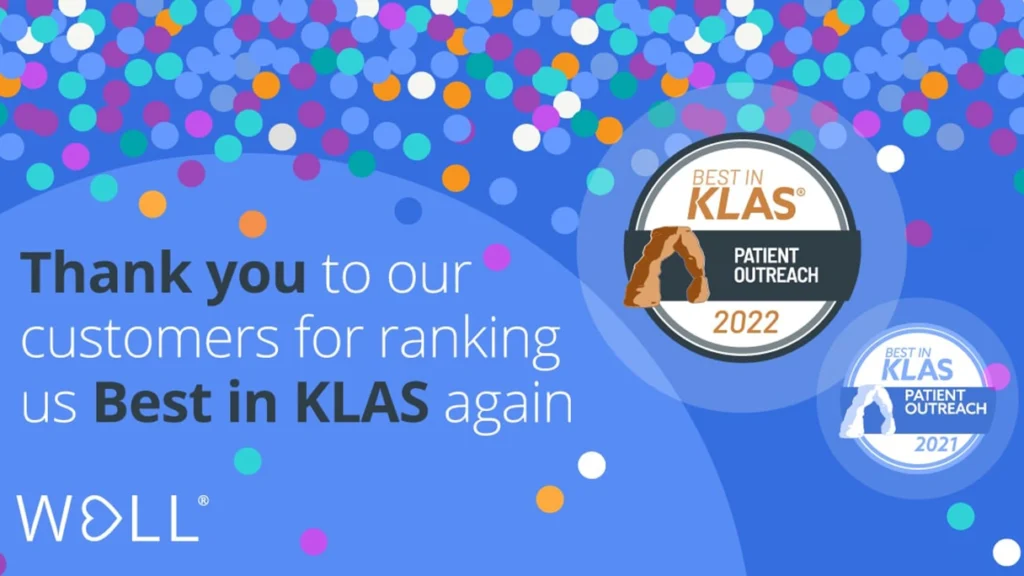
Nowadays, there are a variety of ways to engage and connect with patients. Patient communication platforms, for example, enable streamlined, consistent patient-provider communication – helping patients stay actively involved throughout their care journey. In today’s digital world, the ease and convenience that a patient communication platform offers are exactly what patients are expecting from their health providers.
Patient communication platforms are critical in today’s digital world
According to a 2021 Pegasystems survey, a majority of providers (76%) believe they make it easy for patients to connect with them. The reality? Just over half of consumers (54%) say they are truly happy with existing doctor-patient communication efforts. Patients are demanding more, and providers must embrace modern patient engagement solutions and other emerging healthcare technologies to meet their needs.
As healthcare becomes more patient-centric, digitally connected, and outcomes-driven, the expectations for accessible, efficient patient communications will only continue to evolve. For health systems, engaging patients throughout the patient journey using technology that patients use in their everyday lives is critical to better patient outcomes, improving operational efficiencies, higher revenue, lower costs, and more.
Why does your organization need a patient communication platform?
There may be a number of reasons your organization is searching for a patient communication platform: Staff burnout. No shows. High call volume. Patient satisfaction.
Key benefits include:
- Improved patient satisfaction and outcomes
- Extended reach of key assets like your EHR system and patient portal
- Lower clinician and staff burnout
- Reduced no-shows and costs
- Decreased call volume
- Improved slot utilization
- Increased referral conversion
- Increased staff efficiency
Above all, as patients continue to have more options for their healthcare providers, providing a patient experience that allows your organization to stand out is essential to remaining competitive. Patients of all ages have adopted technology across all facets of their lives and now expect their healthcare interactions to be as seamless as buying items on Amazon. This is where patient communication platforms can step in, enabling much more than traditional one-way email and text systems. Patients are able to choose their preferred channel of communication, such as text, phone, or email, accessing true convenience and efficiency.
It’s clear that now is the time to invest in patient communications. In fact, according to the 2021 Pegasystems survey on patient loyalty, 77% of providers think patients would even switch providers due to poor communications–up a full 103% over last year.
While organizations certainly may have different reasons for adopting patient communication software, it’s important to outline your “why” at the beginning of the evaluation and buying process. Doing so will help you make a more credible decision on a patient communication platform that ultimately aligns with your company’s current needs and long-term goals.
With so many patient engagement platforms out there, however, it can be overwhelming to know where and how to begin your search.
Searching for a patient engagement platform can take time
Health system IT leaders are constantly assessing where to focus their resources, and this is equally true when it comes to determining which unified patient engagement platform to invest in. However, this process is more than just getting executive buy-in and financial commitment. It requires a detailed approach to strategy, implementation, and collaboration with key stakeholders and decision-makers across your organization.
Think about how you orchestrate digital initiatives at your organization and all of the steps that go into the buying process. The same holds true for implementing an effective patient communication platform.
Ultimately, we know the search for any healthcare technology can take time, and that’s why we like to think of it as a journey. So, let’s say you’re just starting out on your journey.
How can you ensure you’re on the right track to picking the best patient engagement platform for your organization?
Criteria for evaluating unified messaging platforms
Identifying your organization’s problems, use cases, and goals is the first step in determining which patient communication platforms may work best for your organization. Thinking through all the details in advance is the best way to set up your project and health system for success.
We’ve outlined four core criteria to consider when starting the evaluation process:
Overall goals:
First, determine your business requirements and overall goals for acquiring a new solution. Since you are considering investing in a patient communication platform, you must have some challenges and issues that you want to solve. Ask yourselves: What are my patient communication goals? List your goals and the top challenges you want to address first.
Identify specific needs:
Outline your “must-have” features and what features would be “nice to have” for a patient communication platform. Start out by listing the top three use cases you are looking to deploy first and why you need them. Next, list any specific capabilities you need and what use cases you want to solve.
Integration with your technology:
Once you have your list of specific needs, think about how the solution fits into your broader technology stack and overall strategy. Identify how many communication solutions you are using today and if they can be consolidated into one unified platform. Outline what integrations will be required.
Your timeline:
Implementing a patient communication solution typically takes three to six months. Determine a timeline for when you need your solution or a deadline for delivery. This will help you stay on track with key milestones and dates.
While these are just a few ideas to get you started, reviewing these can kickstart your evaluation process and help you determine what you should pay attention to throughout the journey. Ideally, these types of questions can further establish your company goals and help identify which patient engagement platforms can truly solve your business needs.
Another factor to keep in mind? Your patients’ goals and desires.
According to a 2020 KLAS survey on patient engagement, providers’ and vendors’ goals and desires aren’t always aligned with those of their patients. Leveraging a patient engagement solution that places great value on patients enables providers to build and augment stronger relationships with them.
To be successful and rewarding for patients, providers, and vendors alike, patient engagement strategies must place patients’ needs and welfare at the forefront.
Features to consider in a patient communication platform
Keep in mind you are looking for the right combination of features that will address your organization’s current needs, resolve key stakeholders’ concerns, support your long-term goals, and manage future challenges. The available features will vary depending on the platform, so it’s best to keep track of what you are looking for and what each vendor can offer you.
We have outlined a few features that most healthcare systems require:
- Automated outreach triggers for patients – Appointment reminders, confirmation requests, recalls, referral workflows, follow-ups, thank you messages.
- Patient and provider texting: Is one-way texting or conversational messaging more effective for your organization?
- Templated responses – Pre-written responses can be created and managed directly by staff. These responses can be shared at different levels across the organization or specific departments to ensure consistency in messaging.
- Inbound keyword triggers – Inbound words or phrases can be set to automatically trigger a response to the patient or an alert to a user or user group.
- Campaign messaging – Bulk outreach to a targeted list of patients to communicate new services or address care gaps, such as flu shot reminders.
- Multilingual support – Send patient messages in their preferred language. List the languages you need to support.
This list of features is really just scratching the surface in terms of what is available in certain patient communication platforms. Think about how your patients would most like to be communicated with, how your organization can effectively do this, and how these changes can influence overall patient outcomes. What other key features come to your mind? Make sure to jot those down throughout the entire process.
Use cases to consider in a patient communication platform
Healthcare technology can not only enhance patient communication but can also improve operational efficiency and patient experience, among a number of other benefits. Most healthcare systems have specific use cases in mind that they are interested in improving with the help of patient communication technology.
Think about what unique use cases your organization would like to improve upon when evaluating patient communication software.
- Appointment automation
- Recalls
- Patient surveys
- Day-of-visit communications
- Post-procedure follow-up
- Virtual waiting room
- Campaigns
Again, there are many other available use cases outside of this list. Make sure to review these and any other use cases you think of with your key stakeholders and decision-makers.
The best patient engagement platform is the one that fits your needs.
At the end of the day, this process is about finding the best patient engagement platform that fits your company’s unique needs and goals. It’s not a one-size-fits-all approach.
Adding any new software to a health system’s tech stack can be daunting – regardless of how helpful the technology will be once it’s implemented. Especially at a time when digital transformation is accelerating quickly, it’s crucial to vet vendors thoroughly.
“Even if a vendor has had success with previous products, technology changes so frequently, it’s important to vet not just the company but the specific product,” said Steve Young, VP of Technology and Innovation at VIA Metropolitan Transit. “There’s a danger in adopting quickly.”
Performing deep diligence ahead of time is the best way to make sure you don’t run into unwelcome surprises later in the implementation or integration processes. In addition, if you can clearly articulate or quantify your own practice’s desired business outcomes, it can often help make discussions with potential technology partners go more smoothly.
The journey for a patient communication platform continues
Remember this is just the first step in the buyer’s journey. Now that you have reviewed the initial criteria to consider when evaluating patient communication platforms, you are well on your way to the next step of the journey: identifying key stakeholders, decision-makers, and their concerns.
Download the WELL Health® Definitive Buyer’s Guide to a Patient Communication Platform – a comprehensive outline of the buying process divided into six easy steps. Reviewing this guide will increase the odds that you will make the right vendor selection for patient communication software.♥


